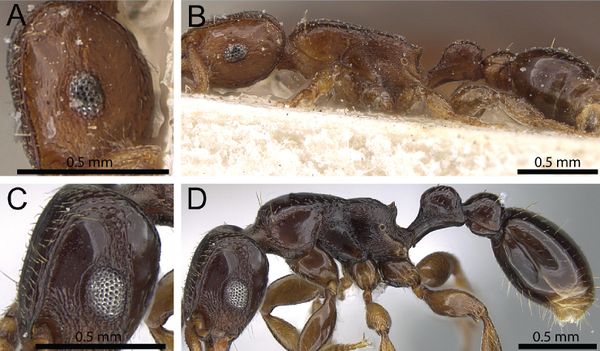Key to Afrotropical Tetramorium decem species group
This worker key is based on: Hita Garcia, F. & Fisher, B.L. 2014. The ant genus Tetramorium Mayr in the Afrotropical region (Hymenoptera, Formicidae, Myrmicinae): synonymisation of Decamorium Forel under Tetramorium, and taxonomic revision of the T. decem species group. ZooKeys 411:67-103.
You may also be interested in
- Tetramorium decem species group
- Afrotropical Tetramorium species groups
- Key to Afrotropical Tetramorium species groups
- Tetramorium
1
- Dorsum of promesonotum with conspicuous longitudinally rugose/rugulose sculpture (Fig. 4A, B) . . . . . 2
- Dorsum of promesonotum unsculptured, smooth, and usually very shiny (Fig. 4C, D) . . . . . 3
2
return to couplet #1
- Slightly smaller species (WL 0.88–0.93); propodeum armed with shorter, triangular, and acute teeth (PSLI 10–11); dorsum of promesonotum longitudinally rugulose with very little ground sculpture, lateral pronotum mostly unsculptured and shiny, only dorsally longitudinally rugulose; generally of uniform dark brown colour; rainforest species [Cameroon, Nigeria] (Fig. 5A, B) . . . . . Tetramorium raptor
- Slightly larger species (WL 0.98–1.06); propodeum armed with longer, triangular to elongate-triangular, and acute teeth (PSLI 16–18); dorsum of promesonotum and lateral pronotum strongly longitudinally rugose with distinct punctate ground sculpture; strongly bicoloured species with dark brown or black gaster contrasting with light brown to reddish brown on remainder of body; savannah species [Cameroon, Ghana, Guinea, Nigeria, and Republic of the Congo] (Fig. 5C, D) . . . . . Tetramorium uelense
3
return to couplet #1
- Generally larger species (WL 1.02–1.16); propodeal teeth relatively longer (PSLI 17–19); petiolar node in profile relatively higher, in profile 1.2 to 1.3 times higher than long (LPeI 77–82); strongly bicoloured species with dark brown or black gaster contrasting with light brown to reddish brown remainder of body [Kenya, Tanzania, and Zimbabwe] (Fig. 6A) . . . . . Tetramorium decem
- Generally smaller species (WL 0.85–0.98); propodeal teeth relatively shorter (PSLI 9–13); petiolar node relatively lower, in profile around 1.0 to 1.2 times higher than long (LPeI 86–100); usually of uniform brown colour, if bicoloured, then only slightly so and never as well developed as above (Fig. 6B) . . . . . 4
4
return to couplet #3
- Smaller eyes (OI 33–36); body colouration uniformly light brown to chestnut brown [Kenya, Mozambique, Tanzania, Zambia, and Zimbabwe] (Fig. 7A, B) . . . . . Tetramorium ultor
- Larger eyes (OI 37–40); body colouration uniformly dark brown to black, always darker than above [Central African Republic, Cameroon, Democratic Republic of Congo, Gabon, Ghana, Kenya, Liberia, Tanzania, Uganda] (Fig. 7C, D) . . . . . Tetramorium venator



